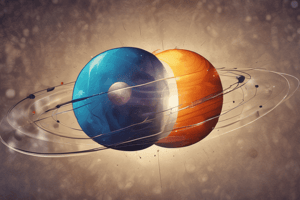Podcast
Questions and Answers
What is the force that causes all objects with mass to fall towards each other?
What is the force that causes all objects with mass to fall towards each other?
- Frictional force
- Electromagnetic force
- Gravitational force (correct)
- Nuclear force
According to Newton's Law of Universal Gravitation, what factor affects the strength of the gravitational force between two objects?
According to Newton's Law of Universal Gravitation, what factor affects the strength of the gravitational force between two objects?
- Velocity of the objects
- Color of the objects
- Amount of mass and distance between the objects (correct)
- Time of the interaction
What is the formula for the gravitational force between two objects?
What is the formula for the gravitational force between two objects?
- $F = G * (m1 * m2) / r^2$ (correct)
- $F = G * (m1 + m2) / r$
- $F = G * (m1 / m2) * r^2$
- $F = G * (m1 - m2) / r^2$
Which physicist formulated the equation for gravity known as General Relativity in 1915?
Which physicist formulated the equation for gravity known as General Relativity in 1915?
What unit is used to measure the gravitational force between two objects?
What unit is used to measure the gravitational force between two objects?
What does mass measure in an object?
What does mass measure in an object?
What effect does an increase in an object's mass have on its gravitational force?
What effect does an increase in an object's mass have on its gravitational force?
What is the equation representing Newton's Law of Universal Gravitation?
What is the equation representing Newton's Law of Universal Gravitation?
What relationship exists between the distance separating two objects and the strength of gravitational force between them?
What relationship exists between the distance separating two objects and the strength of gravitational force between them?
How does the Moon's gravitational force compare to Mars' in relation to Earth's gravitational force?
How does the Moon's gravitational force compare to Mars' in relation to Earth's gravitational force?
Flashcards are hidden until you start studying
Study Notes
Gravity
Gravity is a fundamental property of matter that describes how objects with mass interact with each other. It is the force that causes all objects to fall towards each other. This universal law of physics was first described by Sir Isaac Newton in his book, Principia Mathematica, published in 1687. The equation that best explains gravity is the one formulated by Albert Einstein in 1915, known as General Relativity.
Gravitational Force
Gravity arises from the interaction of the mass, or energy, of two objects. The force of gravity is always attractive, meaning that two objects with mass will be pulled towards each other. The strength of this force depends on the amount of mass each object has, and the distance between them.
The formula for the gravitational force between two objects is given by Newton's Law of Universal Gravitation:
F = G * (m1 * m2) / r^2
Where F represents the gravitational force between two objects, G is the gravitational constant, m1 and m2 represent the mass of each object, and r is the distance between their centers of mass. The unit for the gravitational force is the Newton (N), named after Sir Isaac Newton, who first described gravity as a fundamental property of matter.
Gravity and Mass
The greater the mass of an object, the stronger its gravitational force. This is because mass is a measure of how much matter an object contains, and the more matter an object contains, the greater the amount of energy it possesses, which in turn increases the strength of gravity. Similarly, the closer two objects are to each other, the stronger the gravitational force between them.
For example, the Moon has a smaller mass compared to Earth, but it is closer to us in space. Therefore, while Mars has a larger mass than Earth, it is farther away from us, making its gravitational force relatively weaker compared to the Moon.
Law of Universal Gravitation
Newton's Law of Universal Gravitation describes the magnitude of the gravitational attraction between two point masses, or spherically symmetric bodies, such as planets or stars. The equation for this law is:
F = G * (m1 * m2) / r^2
Where F represents the gravitational force, G is the gravitational constant, m1 and m2 represent the mass of each body, and r is the distance between their centers of mass.
Studying That Suits You
Use AI to generate personalized quizzes and flashcards to suit your learning preferences.




